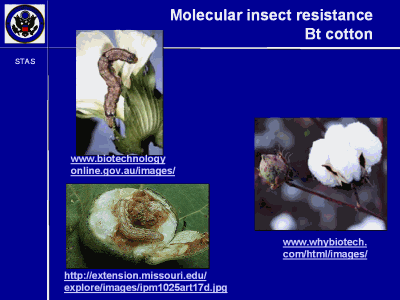| front |1 |2 |3 |4 |5 |6 |7 |8 |9 |10 |11 |12 |13 |14 |15 |16 |17 |18 |19 |20 |21 |22 |23 |24 |25 |26 |27 |28 |29 |30 |31 |32 |33 |34 |review |
 |
There is little doubt that contemporary molecular methods are needed to achieve the kinds of dramatic increases in productivity required to meet the growing demand for food and biofuels. I remind you that increases in farm land today are largely bought at the cost of our ever shrinking wildlands, particularly in the tropics, where every acre lost takes into extinction species we’ve not yet even identified. We have the requisite molecular tools: they’ve been used to introduce genes that confer insect resistance and herbicide tolerance on crop plants. Here is one of the insects that attacks cotton and the damage it does -- and here is Bt cotton*, cotton containing a bacterial gene encoding a protein that is toxic to insects, but not people. |